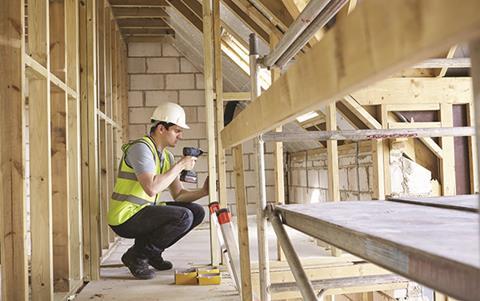The built environment industry is facing a skills gap on an unprecedented scale. That’s the key message to emerge from a new report pulled together by the University College of Estate Management (UCEM).

Some of the issues identified are well known, such as the potential loss of overseas labour as a result of Brexit.
The report also points to rising demand for skills in areas such as infrastructure, as well as the need for new skills to enable offsite construction. The scale of the housing crisis and the talent required to increase delivery are also highly challenging, according to UCEM.
In addition to detailing the problems facing the built environment, the report also draws on advice from industry experts and attempts to chart the way forward. Here, three contributors to the report explain what needs to change if the skills gap is to be resolved.

Amanda Clack, executive director at CBRE and immediate past president of RICS
When you look at the pipeline of work that’s coming, effectively you’ve got HS2, Hinkley and Heathrow alongside ongoing highways, housing and heritage projects.
Tackling the skills gap will be critical if we are to successfully complete such a large volume of work on time and the government is to deliver on the promises it has made on the delivery of key infrastructure projects.
Collaboration, through focusing on responsive engagement and partnership between the government and the private sector, is needed to realise our ambitions.
Stabilisation is the key ask of government. Over 50% of the construction workforce in our sector are non-UK nationals. We really need to think about how we make sure that we stabilise in the short term because the new talent pipeline coming through is going to take time to arrive. We must ensure the migrant workforce is able to remain in the UK in the short to medium term.
This stabilisation is really needed and the government can help by getting key skills in construction on to its critical skills shortage list.
If we’re serious about the skills gap, we must also consider how to make the sector more attractive. We need to think differently about messaging if we’re going to attract people into a sector that is naturally perceived as ‘pale, male and stale’.
We also need to consider pathways for entry and how we actually make sure that the people we’re training have the right skills to make them employable in the future. This includes thinking about digitalisation and innovation and schools.
We need to talk about the built environment as a whole, rather than focus on individual professions, to make it relevant.
Closing the skills gapthrough diversity and inclusion is important as it makes business sense to attract the top talent. It’s not just gender balance but, from a RICS perspective, just 13% of qualified members are female and among trainees and graduates it’s at 25%. So clearly we have to do more on the male-to-female ratio.
There are opportunities for everyone within our sector and what we want are the best possible people to work and operate within it. It’s about addressing diversity and inclusion because unless we really start to address both we’ll miss out on future talent.
James Wates CBE, chairman of BRE Trust, Wates and CITB
There are more than three million people working in the built environment in the UK, representing nearly a 10th of the entire workforce. Employing those three million people are more than one million different businesses.
So to say that the built environment sector is fragmented is a massive understatement. It presents us with some significant challenges when it comes to recruiting, training and, more importantly, retaining the workforce we need. While there are some great examples of collaboration, they are taking place in an environment that is culturally and structurally resistant to it. This situation has to change.
Think of this from the perspective of the 700,000 16-year-olds who every year finish their GCSEs. Many of them do want to go into the built environment (not enough, but many do). Where do they go next? The world of work and apprenticeships or continue their education – sixth form, UTC, local FE college, A levels, BTECs or tomorrow’s T levels? When you look at the skills landscape from a young person’s perspective, you’ve got a huge number of different paths with uncertain destinations.
To really counteract fragmentation, the whole industry needs to be getting behind joint efforts. We need to avoid individual companies reinventing the wheel and designing their own school or community outreach programmes and do it collectively.
The Construction Industry Training Board plays an incredibly important role and its direction of travel, having heard complaints from the industry loud and clear, is to be more strategic and focused on impact. The government is leading on the creation of IT levels and a more rigorous incorporation of work experience into further education.
These are positive signs for the effort to simplify and clarify for young people how they can enter the construction industry and develop skills that are in demand. Ultimately, I hope that the changes will tackle the esteem gap between vocational and academic routes.
The Apprenticeship Levy and a greater emphasis on higher and degree apprenticeships can also potentially really help to address the mismatch of supply and demand of skills.

Mark Farmer, founding director and chief executive, Cast Real Estate and Construction Consultancy
The resourcing and size of our workforce, both now and going forward, is becoming an all-consuming industry issue. In addition, the demographics of that workforce create a real concern, which is that the resilience that we’re known for in the industry is not sustainable. We are highly cyclical in terms of what we do as we shed and regain labour depending on economic cycles.
That resiliency is under pressure in a way that we have not seen before. We cannot look forward based upon statistics and trends from the past. This is a new period we’re entering into and the prognosis is declining industry resiliency.
Future skills recommendations can be condensed into the following factors:
• Integrated leadership – the need for clear leadership and institutional reforms that better integrate clients, industry and government;
• A productivity-led change agenda letting innovation dictate future skills development that clients and the supply chain can either lead on or respond to;
• The government has to play a critical role in the strategic initiation of change across both of the above.
This is all about push-pull in our market; how much the industry can push around different ways of doing things and be pulled in a certain direction.
The government must adopt an enabling policy that supports us to do things differently. A theme within the Farmer Review of the UK Construction Labour Model (2016), which I authored, is all about changing the way we deliver construction and changing the balance of what we do in a traditional construction environment on site and what we do in a pre-manufactured environment.
Somehow, we have to create a situation where clients are commissioning work in a different way (the industry needs that pull).
We need progressive clients commissioning consultants who influence supply chain behaviour. This demand needs to be strong enough to allow contractors to plan ahead, so there is a clear journey over the next five years as to how we move from traditional skills to a workforce equipped to meet future demand.


























![Rob J Headshot[14]](https://d2bq2usf2vwncx.cloudfront.net/Pictures/380x253/8/5/5/1884855_robjheadshot14_607979_crop.jpg)



No comments yet